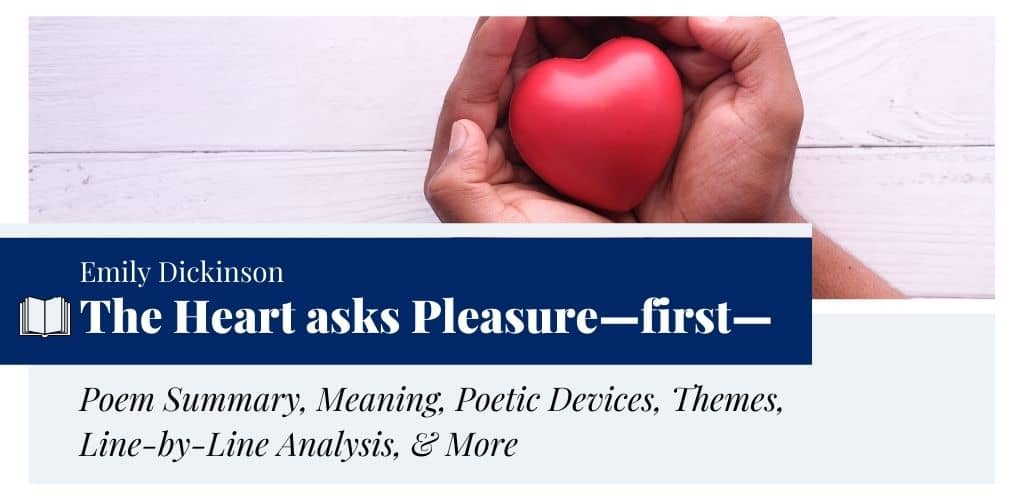The Heart asks Pleasure—first— by Emily Dickinson
“The Heart asks Pleasure—first—” first appeared in Emily Dickinson’s Poems (1890). The unadulterated version of the text appears as the 536th poem in Complete Poems (1955) edited by Thomas H. Johnson. This short poem is composed in a simple style. It explores the basic desires of the heart—to seek relief from suffering, pleasure from pain, rest from unrest. In this poem, Dickinson’s tone is instructive and informative as she lists what the heart really wants sequentially and confidently. This poem captures the poet’s preoccupation with death, seclusion, and heartache.
- Read the full text of “The Heart asks Pleasure—first—” below:
The Heart asks Pleasure—first— by Emily Dickinson The Heart asks Pleasure—first— And then—Excuse from Pain— And then—those little Anodynes That deaden suffering— And then—to go to sleep— And then—if it should be The will of its Inquisitor The privilege to die—

Summary
Dickinson’s “The Heart asks Pleasure—first—” notes the requests of the heart. It explains the simplest desires of a person, to seek pleasure and balance. Firstly, all a person wants is pleasure, to live to the fullest even with the occasional painful events. His heart asks for a life without pain that is filled with everlasting happiness. If that doesn’t happen, the heart wants Anodynes (traditional painkillers) for relief, which will ease the suffering.
In the next stanza, Dickinson says that if the person can’t escape from their hardships, then their heart desires to sleep. At last, if the sequential sufferings don’t come to an end, it seeks permission of conscience, “The will of its Inquisitor,” to die.
Meaning
“The Heart asks Pleasure—first—” is a short but philosophical poem that dwells upon the basic human needs: pleasure, an escape from pain, and death. Though the title of the poem suggests that a person’s heart prioritizes pleasure and joy the most, Dickinson points out that sometimes the pain can be so overwhelming that a cure, escape, or even death would be a better relief. The poet’s views on emotional needs might seem far too simplistic but in a way, she dictates the story of most people in the world. Who does not want pleasure or seek death from everlasting suffering?
Form, Rhyme Scheme, & Meter
“The Heart asks Pleasure—first—” consists of a total of 8 lines, divided into two quatrains. It does not have a regular rhyme scheme. Like other Dickinson’s poems, though it does not contain slant rhymes, readers can find the use of internal rhymings. There is a set metrical pattern in the text. In each stanza, the first, second, and fourth lines are in iambic trimeter, and the third line is in iambic tetrameter. Let’s have a look at the scansion of the poem:
The Heart/ asks Plea/-sure—first—
And then/—Ex-cuse/ from Pain—
And then/—those lit/-tle A/-no-dynes
That dead/-en suf-/fer-ing—
And then/—to go/ to sleep—
And then/—if it/ should be
The will/ of its/ In-qui/-si-tor
The pri/-vi-lege/ to die—
Poetic Devices
Dickinson uses poetic devices in order to illustrate all that a human heart needs. The devices used in the poem are as follows:
- Anaphora: The speaker begins lines 2-3, and lines 5-6, and lines 7-8 with “And then” and “The,” respectively. In this way, Dickinson lists out the heart’s wants in order of preference and describes the cycle of life.
- Personification: The poet says, “The Heart asks Pleasure—first—,” by giving human characteristics to the heart. Here, she actually refers to human beings as a whole by referring to a part of their body. Hence, it is a use of synecdoche as well.
- Metaphor: In the line “The will of its Inquisitor,” the speaker compares conscience to an inquisitor. Without its due permission, none can decide to die.
- Enjambment: It occurs in the lines, “And then—those little Anodynes/ That deaden suffering—” and “And then—if it should be/ The will of its Inquisitor.”
- Alliteration: This device is used in “That deaden,” “if it,” “its Inquisitor,” etc.
Line-by-Line Analysis & Explanation
Lines 1-4
The Heart asks Pleasure—first—
And then—Excuse from Pain—
And then—those little Anodynes
That deaden suffering—
In the first verse, Emily Dickinson explains what the heart desires the most. Her speaker says that the heart primarily wants to have pleasure, celebrate, and live life to the fullest. The first thing the heart craves is “Pleasure” and not the absence of pain, but an “Excuse from Pain.” These lines set a whimsical yet realistic mood in the poem.
In the second line, the speaker says that the heart wants an “Excuse” from suffering and pain. This does not mean a complete absence of pain, but a break from it, an escape. If an excuse cannot soothe the heart, the speaker asks for traditional painkillers, Anodynes, that would “deaden” (end) the suffering.
In the first four lines, Dickinson personifies the heart, pain, and anodynes by capitalizing their first letters as a way to express the depth of her emotions. Her tone is simplistic, and her voice has a conviction in what she says.
Lines 5-8
And then—to go to sleep—
And then—if it should be
The will of its Inquisitor
The privilege to die—
In the second verse, the speaker says that if the heart cannot get an excuse or anodyne for its ache, it desires to sleep, a temporary escape from all the hardships. However, in the end, the poet says that if sleep fails to cure heartache, the heart desires death or, instead, the liberty to die. In that case, it has to ask its “Inquisitor,” conscience. It can also be a reference to God. For a person who goes through lifelong suffering, death is a kind of “privilege.”
By the term “Inquisitor,” the speaker might be referring to the person she loves. As she has already given her heart to the person, that person becomes the “Inquisitor.” Only he can allow her to die.
Themes
Dickinson’s “The Heart asks Pleasure—first—” highlights the themes of the desires of the heart and the cycle of pain and pleasure. As opposed to the title of the poem, Dickinson talks more about pain than pleasure. In any case, her poetic persona seems to have grasped that there can be no life without pain. Thus, instead of saying that the heart desires a life without pain, she says that her heart asks for an excuse, or cure, or an escape from pain. This mirrors the life of an average person who is riddled with hardships in life.
At the end of the poem, the speaker expresses her heart’s desire to die. Death is a very characteristic topic for Emily Dickinson’s poems. The heart knows that suffering is a certainty in life. However, it is so tired that it asks its “Inquisitor” for the liberty to die. She uses the word “will” instead of the term “permission” as if death would be equivalent to the master of her fate.
Historical Context
Emily Dickinson’s poems achieved recognition after her death in 1886. Only seven out of 1,800 of her poems were published before her death. Her poems have short lines, slant rhymes, unique capitalization, and punctuation—a signature to her style. They possess Dickinson’s deep knowledge about life, love, nature, and death. The poem “The Heart asks Pleasure—first—” truly captures her genius. It was published in Book I, “Life” of Poems (1890), the first collection of Dickinson’s poetry. The unaltered version of the poem was published as poem number 536 in Complete Poems (1955).
Questions & Answers
This poem is about the desires of an aching heart. It highlights what a person needs the most, down to the least: pleasure, an escape from pain, Anodynes (painkillers), sleep, and death.
This piece consists of two quatrains without a specific rhyme scheme. Dickinson uses internal rhymings within the lines. Besides, this poem is composed of iambic trimeter and iambic tetrameter. It is written from the perspective of the poet’s aching heart.
The theme of the poem orbits around the desires of an aching heart. As opposed to the title, the poem also comments on how pain makes the speaker’s heart weary, so much so that death would feel like a sort of “privilege.” Besides, the cycle of pleasure and pain is another underlying theme of the poem.
Dickinson refers to her conscience or God as an “Inquisitor.” An inquisitor is one who looks for or inquires into heretical incidents. In the poet’s case, her conscience is the one who would inquire into her state and judge whether her death plea is fit for approval. It can also be a reference to a loved one to whom she has surrendered her heart. In a way, she lives for that person and cannot die without his permission.
The poetic devices used in the poem are personification, enjambment, alliteration, anaphora, and metaphor. Dickinson uses these devices to make her thoughts more appealing to readers.
Similar Poems about the Heart
- “Have you got a brook in your little heart” by Emily Dickinson — This poem is about the soul that is compared to a little brook.
- “My True Love Hath My Heart” by Sir Philip Sidney — This piece explores how the exchange of genuine emotions is essential for a strong relationship.
- “A Sad Child” by Margaret Atwood — In this poem, Atwood addresses children who feel sad and discouraged due to some unforeseen events.
- “I’m “wife” — I’ve finished that —” by Emily Dickinson — This piece describes one of the reasons for Dickinson’s heartache.
External Resources
- Full text of Poems (1890) — Explore more poems from the first collection of Dickinson’s poetry.
- A bomb in her bosom: Emily Dickinson’s secret life — Read about the closely guarded secret of the poet’s life and her fiercely passionate nature.
- About Emily Dickinson — Learn about Dickinson’s life and works.
- Poet Profile & Poems of Emily Dickinson — Read more about the poet and read some of her best-known poems.
- Check out The Complete Poems of Emily Dickinson — Listen to this free audiobook available only on Audible.






